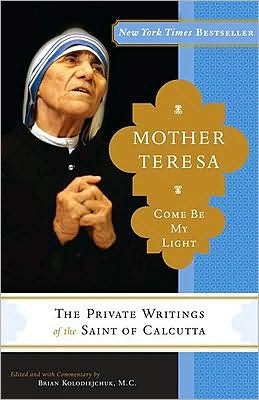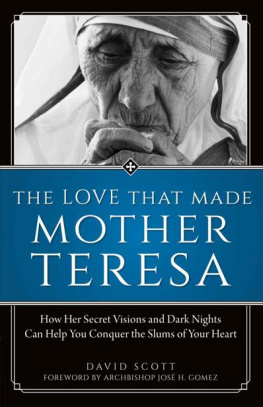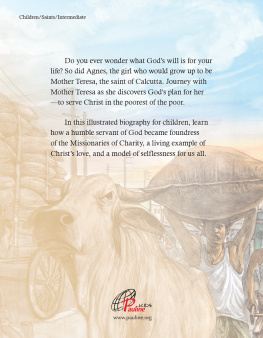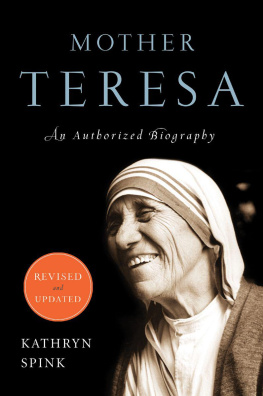
CONTENTS
ONE
Put Your Hand in His Hand, and Walk Alone with Him
TWO
Something Very Beautiful for Jesus
THREE
Come, Be My Light
FOUR
To Bring Joy to the Suffering Heart of Jesus
FIVE
Delay No Longer. Keep Me Not Back.
SIX
To the Dark Holes
SEVEN
The Dark Night of the Birth of the Society
EIGHT
The Thirst of Jesus Crucified
NINE
My God, How Painful Is This Unknown Pain
TEN
I Have Come to Love the Darkness
ELEVEN
At His Disposal
TWELVE
God Uses Nothingness to Show His Greatness
THIRTEEN
Radiating Christ
For those, especially the poorest of the poor, who find themselves in any form of darkness, that they may find in Mother Teresas experience and faith, consolation, and encouragement.
If I ever become a SaintI will surely be one of darkness. I will continually be absent from Heavento light the light of those in darkness on earth
Mother Teresa of Calcutta


PREFACE
For decades, Mother Teresa and her work received extensive public interest. In view of all the attention she garnered during her lifetime, and particularly at the time of her death at the age of eighty-seven, the question arises: What was the source of this attractive force drawing so many people to her? She would have certainly preferred to remain unnoticed. She considered herself just a pencil in Gods hand1 and was convinced that God was using her nothingness to show His greatness. She never took credit for her accomplishments and always tried to divert the attention she received to God and His work among the poorest of the poor. Yet it was not in Gods providential plan for her to remain unknown. People of all creeds and walks of life recognized her selfless love and compassion for the poor; they admired her simplicity and genuineness and were attracted by the joy and peace that radiated from her. At the same time, all those who met her, even just once, were left with the sense that there was something more behind her penetrating gaze.
Mother Teresa could not hide her work among the poor, but what she did manage to keep hiddenand with astonishing successwere the most profound aspects of her relationship with God. She was determined to keep these secrets of love far from mortal eyes. The late archbishop Ferdinand Prier of Calcutta and a few priests were the only ones who had some insight into the spiritual wealth of her interior life, and even with them she constantly begged that they destroy all her letters regarding it. The reason for such insistence can be found in her deep reverence for God and His work in her and through her. Her silence now stands as a testimony to her humility and the delicacy of her love.
Providentially, Mother Teresas spiritual directors preserved some of her correspondence. Thus, when testimonies and documents were gathered during the process for her beatification and canonization, the remarkable story of her intimate relationship with Jesus, hidden from even her closest collaborators, was discovered. In contrast to her ordinariness, Mother Teresas confidences reveal previously unknown depths of holiness and may very well lead her to be ranked among the great mystics of the Church.
Her life and message continue to fascinate. This book, then, is a response to the plea of many who knew, loved, and admired her and who desire to know the motive of her action, the source of her strength, the reason for her joy, and the intensity of her love. These pages unveil her interior life, with all its depth and drama, and add unsuspected riches to the spiritual heritage Mother Teresa offers to the world.
Father Brian Kolodiejchuk, M.C.
Postulator, Cause of Canonization of Blessed Teresa of Calcutta
Director, Mother Teresa Center
Introduction
If I ever become a SaintI will surely be one of darkness. I will continually be absent from Heavento light the light of those in darkness on earth.1 Taken as a kind of mission statement, these words of Mother Teresa provide a key to the understanding of her spiritual life, and indeed of her whole life. Come be My light, Jesus had requested, and Mother Teresa strove to be that light of Gods love in the lives of those who were experiencing darkness. For her, however, the paradoxical and totally unsuspected cost of her mission was that she herself would live in terrible darkness. In a letter to one of her spiritual directors she wrote:
 Now Fathersince 49 or 50 this terrible sense of lossthis untold darknessthis loneliness this continual longing for Godwhich gives me that pain deep down in my heartDarkness is such that I really do not seeneither with my mind nor with my reasonthe place of God in my soul is blankThere is no God in mewhen the pain of longing is so greatI just long & long for Godand then it is that I feelHe does not want meHe is not thereGod does not want meSometimesI just hear my own heart cry outMy God and nothing else comesThe torture and pain I cant explain2
Now Fathersince 49 or 50 this terrible sense of lossthis untold darknessthis loneliness this continual longing for Godwhich gives me that pain deep down in my heartDarkness is such that I really do not seeneither with my mind nor with my reasonthe place of God in my soul is blankThere is no God in mewhen the pain of longing is so greatI just long & long for Godand then it is that I feelHe does not want meHe is not thereGod does not want meSometimesI just hear my own heart cry outMy God and nothing else comesThe torture and pain I cant explain2
Aim of the Book
This book plumbs the depth of Mother Teresas interior life seen from the perspective of this mission statement. Rather than a theological study, this work is a presentation of the previously unknown aspects of her interior life, through which we gain greater insight into her resolute faith and intense love for God and neighbor.
Three aspects of Mother Teresas interior life revealed during her cause of canonization are the private vow made while she was still a Loreto nun, the mystical experiences that surrounded the inspiration to found the Missionaries of Charity, and her intimate sharing in the Cross of Christ through the long years of interior darkness. Each of these elements is connected: the private vow laying the groundwork for the call to serve the poorest of the poor, the new call inviting her to embrace the spiritual reality of those she served, and the vow again supporting her heroic living of the painful darkness.
The book is divided into four parts. Chapters 1 and 2 cover her interior life prior to her call within a call. Love for God and neighbor had been planted in her heart since her early childhood. Her generous response already as a youth in Skopje, and particularly as a dedicated and self-sacrificing Loreto nun, reached its peak in a private vow she made in 1942. This vow proved to be not only the driving force behind her actions, but also a providential preparation for what lay ahead.
Chapters 3 through 7 deal with the inspiration she received on September 10, 1946, to found the Missionaries of Charity, the drama of waiting to start her new mission, and, finally, her leaving the Loreto order and beginning the work in the slums. Both in answering the call within a call and in the slow process of discernment that followed, she faced bravely the many sufferings that came her way and held firmly to her new mission.
When all seemed to be in place, the worst of her ordeals was only just beginning. From the time she received the call, she was convinced that her mission was to bring the light of faith to those living in darkness. Little did Mother Teresa realize that darkness would become the greatest trial of her own life, and a fundamental part of her mission. The depth of this mystical experience and the cost of living out this new call and mission are the themes of Chapters 8 through 13.
Next page













 Now Fathersince 49 or 50 this terrible sense of lossthis untold darknessthis loneliness this continual longing for Godwhich gives me that pain deep down in my heartDarkness is such that I really do not seeneither with my mind nor with my reasonthe place of God in my soul is blankThere is no God in mewhen the pain of longing is so greatI just long & long for Godand then it is that I feelHe does not want meHe is not thereGod does not want meSometimesI just hear my own heart cry outMy God and nothing else comesThe torture and pain I cant explain2
Now Fathersince 49 or 50 this terrible sense of lossthis untold darknessthis loneliness this continual longing for Godwhich gives me that pain deep down in my heartDarkness is such that I really do not seeneither with my mind nor with my reasonthe place of God in my soul is blankThere is no God in mewhen the pain of longing is so greatI just long & long for Godand then it is that I feelHe does not want meHe is not thereGod does not want meSometimesI just hear my own heart cry outMy God and nothing else comesThe torture and pain I cant explain2